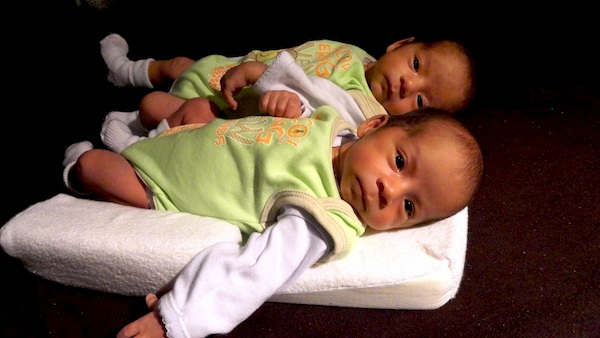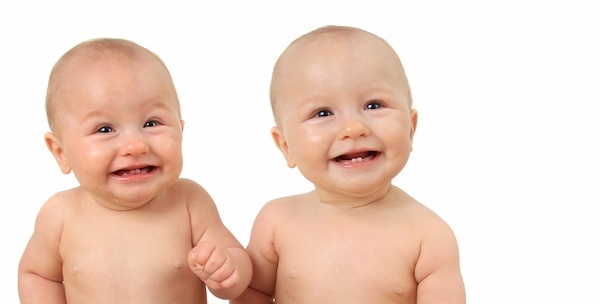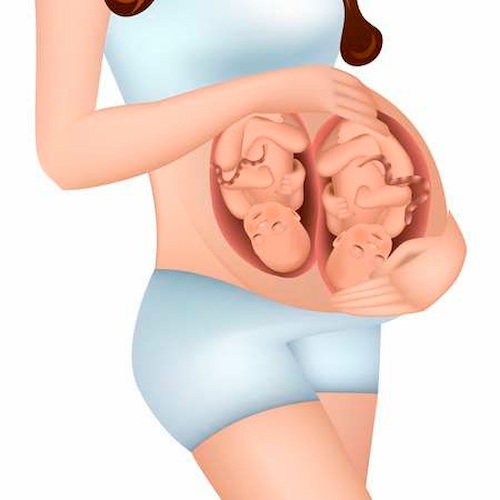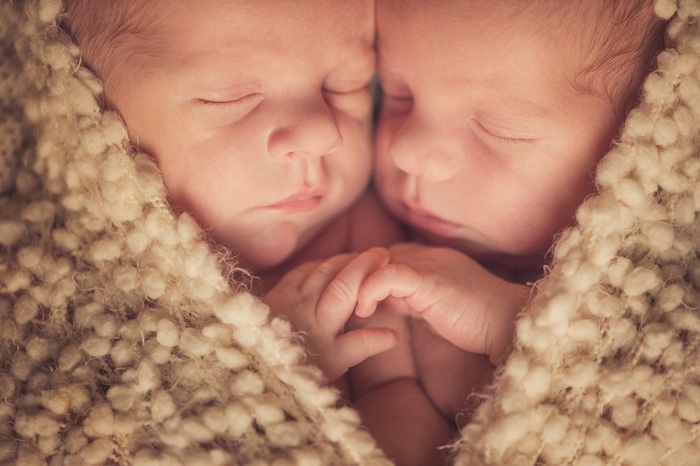Author: Kath Doyle
When parents find out that they are expecting multiples, on top of the inevitable shock they are faced with a whole new language. Terms like chorionicity, amnionicity and zygosity along with acronyms like MCDA and DCDA start to be thrown around very early and it can be confusing and overwhelming. For the sake of simplicity we will just refer to twins in this article.
So, here is a quick breakdown of these terms.
Note from Twinfo: You can read our “Dictionary for Common Multiple Birth Terms HERE.
What is Zygosity?
Zygosity in the context of multiples refers to how genetically similar or different they are. While there are uncommon cases which do not fit neatly into these two categories, the vast majority of twins are either monozygotic (identical) or dizygotic (fraternal).

Monozygotic Twins
Monozygotic or identical twins develop from a single zygote, or fertilised egg, which splits into two after fertilisation. In rare cases it may split further and identical triplets or quadruplets are formed. Monozygotic twins have essentially the same genetic information or DNA (technically there will be some very slight differences due to mutations). Monozygotic twins will almost always be the same sex (there are some extremely rare exceptions resulting from genetic mutation).
Dizygotic Twins
Dizygotic or fraternal twins are formed from two eggs which are fertilised by two sperm and are as genetically similar yet unique as any siblings. This means that they may look very alike or very different.
There is a common misconception in the multiples world that zygosity can easily be determined by looking at the way a pregnancy is set up. The common belief, often incorrectly shared by medical professionals, is that identical twins share a placenta and fraternal twins have their own placentas. While both of these statements are true, they are an over-simplification of the facts.
Chorionicity refers to the number of placentas. Multiples can either share a placenta (monochorionic) or have their own placentas (dichorionic in the case of twins, trichorionic for triplets). Amnionicity refers to the number of amniotic sacs. Again, multiples may share or have their own. The more things that are shared, the higher risk the pregnancy.

There are three types of twin pregnancy
Dichorionic-diamniotic (DCDA)
DCDA twins have their own placentas and amniotic sacs. Sometimes the placentas can fuse and appear to be a single placenta on an ultrasound. Earlier scans are usually more accurate at determining the number of placentas if this happens. Often DCDA is used interchangeably with the term fraternal, but this is not accurate. While almost all fraternal twins are DCDA (the exceptions to this are extremely rare), not all DCDA twins are fraternal. Around 30% of identical twins will also be DCDA.

Monochorionic-diamniotic (MCDA)
MCDA twins share a placenta but have their own amniotic sacs. MCDA twins are (with extremely rare exceptions) identical. 60-70% of identical twins will be MCDA.
Monochorionic-monoamniotic (MCMA)
MCMA twins share both a placenta and amniotic sac. MCMA twins are always identical. This type of pregnancy is rare and high risk.

Could my twins be identical? Or fraternal?
The two easiest ways to know are if they are different sexes or have different blood types. While there are extremely rare exceptions to both of those rules, in the vast majority of cases boy/girl twins and twins with different blood types will be fraternal. Of course, having the same blood type doesn’t automatically make twins identical. It is not uncommon for siblings to share a blood type.
Parents often determine zygosity by whether their twins look identical or not. Sometimes this is easy to do. It’s a reasonable assumption that if one twin has blonde hair, fair skin and blue eyes while the other has dark hair, olive skin and brown eyes that they are fraternal. It is not always that easy, though. Often siblings have the same colouring and similar facial features, and fraternal twins are no exception.
“Mum Goggles” and identical twins
However, and I say this as the parent of identical twins who is guilty of this, as parents we are often the worst judges of our children’s zygosity. Even identical twins have subtle differences. Sometimes these differences are easy to point out to other people like a birth mark or a freckle. Often they are very subtle, just slight differences in the shape of the face which we can’t even articulate to other people, which add up to two completely different faces in our mind.
When a stranger looks at twins the most striking things they notice are the similarities. When parents look at their twins, they are far more tuned into those subtle differences and, to the complete bewilderment of everyone else, often over time come to see their identical twins as looking completely different. This effect is further enhanced by differences in personality, facial expression and voice.
This phenomenon is often referred to as wearing “mum goggles”.

When people ask me how to tell my twins apart, I usually point out the forehead scar which one twin conveniently acquired in a moment of 2 year old clumsiness. The truth is far more difficult to articulate. When my husband, myself or my other children look at our twins, they just look different. Even though I know that to everyone else they look exactly the same. Yes, I have a strong pair of mum goggles.
So, could my twins be identical?
You don’t have to spend long in Facebook support groups for parents of multiples to see this phenomenon in action. It’s a regular occurrence for a parent to post a photo of their “obviously fraternal” twins and express exasperation and confusion as to why everyone else thinks they’re identical.
Various reasons are given for why they can’t be identical – they were told by a medical professional during their pregnancy that they were having DCDA and therefore fraternal twins, they were different sizes at birth, or as parents they have no trouble telling them apart. None of these rule out monozygosity in same-sex twins. The comments will inevitably be full of people assuring the parents that they do actually appear to be identical and that they might want to consider DNA testing.
DNA testing for twins
DNA testing can be done using blood or cheek cell samples, the benefit of the latter being that parents can collect the samples themselves. A testing kit is sent out with instructions, the parents use the swabs enclosed to collect a sample of cheek cells (this can be done on even very young infants, our twins were only a few weeks old), and the swabs are returned via mail. Results are usually available in a week or two.

Zygosity testing is done by comparing around 11-15 specific genetic regions. If twins are monozygotic, these regions will match. It is highly unlikely for non-identical individuals, even dizygotic twins, to have identical DNA sequences in these regions. Results are therefore given as “identical DNA” (monozygotic twins) or “non-identical DNA” (dizygotic twins). For twins identified as identical, a percentage (usually over 99.9%) is given to indicate the likelihood that they are identical based on the specific test conducted. This percentage is not actually a measure of how much DNA a pair of identical twins share or how identical they are. Although it is often misinterpreted as such.
If you are a member of the Twins Research Australia, (which is free to join) you can get a significant discount on zygosity testing.
My personal experience of DNA testing our twins
We tested our twins even though they were MCDA and therefore almost certainly identical. I was expecting two babies who were virtually clones of each other and was surprised when they looked very different. If they were DCDA and we had been told they were fraternal, I would have accepted that without question. In fact, nobody had difficulty telling them apart initially. Twin A was 500g larger and had a lot more hair. Their heads were very different sizes and shapes due to their different positions in the womb. When we got the results back confirming that they were in fact identical, our Paediatrician even asked if we were sure we hadn’t swabbed the same baby twice! It wasn’t until somewhere between their first and second birthdays that it became more obvious that they were identical.
So, the moral of this story? If family, friends and strangers are constantly asking you if your same sex twins are identical, or if you have ever wondered ‘Could my twins be identical?’, it might be worth doing that DNA test even if you can’t see it.
You might be surprised by the results, or at the very least you’ll have written proof that you were right.

